Do you want more views on YouTube? Do you want to grow your subscriber base and drive more people to your business? If so, you need to understand how the YouTube algorithm works.
81% of YouTube users say they watch videos suggested by the YouTube search algorithm. The recommendation algorithm drives 70% of all views on the platform. It’s a fundamental component of YouTube, and as a creator, you can’t ignore it.
Like most search engines, YouTube isn’t entirely transparent about their algorithm. They don’t want creators to know exactly how it works, otherwise those creators would create content that serves the algorithm, not their viewers.
Nevertheless, through careful study and experimentation, and some comments by the team at YouTube, we know a bit about the algorithm’s process.
In this article, we’ll shed some light on how YouTube algorithm works and how you can use it to your advantage when starting your YouTube channel.
What is the YouTube Algorithm?
The YouTube algorithm is a set of computer processes used by YouTube to determine which videos to display and recommend to users. This algorithm aims to keep users engaged on the platform by offering them content tailored to their preferences and viewing history.
The specifics of the algorithm are proprietary to YouTube and are not disclosed fully to the public. However, through observations and statements from YouTube, we know it involves factors like watch time, user feedback, video freshness, channel authority, and more.
The YouTube algorithm is continuously evolving. The platform makes regular changes to how content is recommended and ranked based on a multitude of factors. This means strategies that work at one time might not be as effective in the future.
As a content creator, it’s important to understand the algorithm so you can produce high quality, engaging content that resonates with your audience and makes it into their feed.
Brief History of the YouTube Algorithm
Before we dive into how the YouTube algorithm Works today, let’s take a short walk through history.
2005 to 2011
In the beginning, YouTube didn’t have an algorithm. Recommendations were based on views. During this period, YouTube’s algorithm prioritizes videos to get the most clicks. This is the beginning of the clickbait era. Some creators would use misleading or deceptive titles and thumbnails to convince you to click on their videos, thereby bringing their content to the top.
2012 to 2014
YouTube reengineers the algorithm to focus on watch time and percent-of-video completion. Some creators focused on long-form content to secure more watch time. other creators focused on short-term content to achieve better percent-of-video completion. Unfortunately, it did not make the overall quality any better.
2015
2015 was a big year. YouTube invested deeply into data science to invent a new way of suggesting content to users. Instead of using overall popularity and other broad metrics, YouTube would now recommend content based on user preferences and behavior. For the first time, how you interact with YouTube determines the content you see.
2016
2016 was the beginning of content moderation. This is when YouTube began to take deliberate steps to remove harmful content and misinformation. creators are now subject to community guidelines or risk having their content demonetized or removed.
How Does the YouTube Algorithm Work in 2023?
YouTube pushes videos to users based on user feedback. User feedback can be explicit, such as clicks, likes, or subscriptions, or implicit, such as watch time and shares.
Interestingly, YouTube doesn’t evaluate the content at all, just how people interact with it. “Our algorithm doesn’t pay attention to videos; it pays attention to viewers. So, rather than trying to make videos that’ll make an algorithm happy, focus on making videos that make your viewers happy,” says YouTube.
Over time, YouTube builds a profile on each user. Artificial intelligence models and machine learning use that profile to sort content and show you options that you’re likely to engage with. Here’s the two-step process that explains how it works.
- Step 1: Candidate Generation: The algorithm picks out a few hundred videos from their entire library of billions of videos. The candidates reflect the user’s demographic data, as well as explicit and implicit feedback.
- Step 2: Ranking Video Candidates: Now that YouTube has a bank of videos you’d like, it ranks them by engagement. Videos with more views, likes, shares, and comments get a higher score. Then the platform offers videos to you based on that score. (Some randomness is built-in so you don’t get bored.)
You can see recommendations from the algorithm in three places:
Home Page
You’re undoubtedly aware of the home page, but it isn’t the same for everyone. It’s curted for each user based on the results of the algorithm, channels you’re subscribed to, and videos with especially high engagement. (For instance, you may see a Superbowl video even if you’ve never interacted with Superbowl content.)
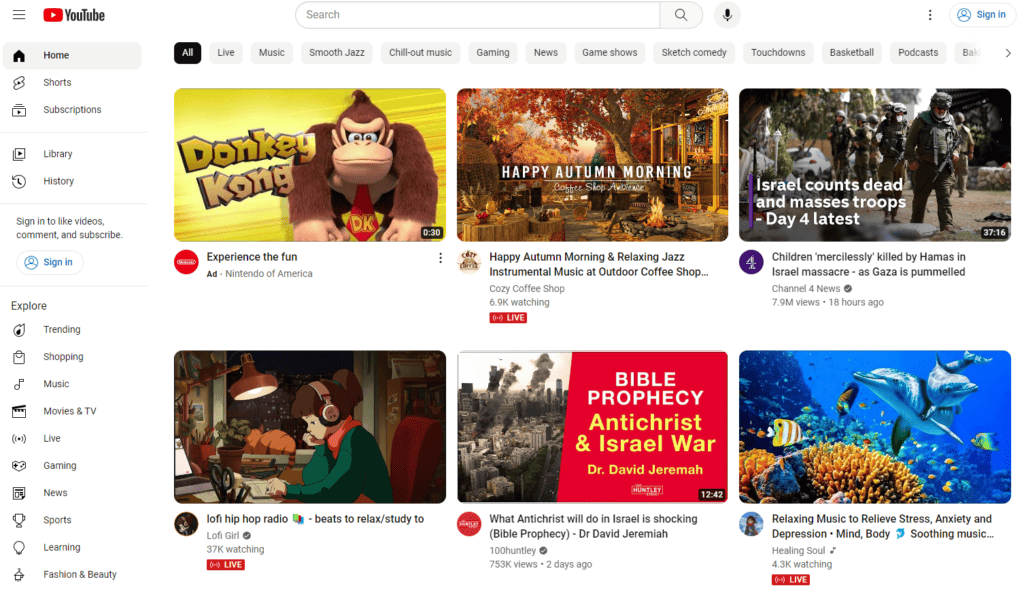
Suggested Videos
Suggested videos are recommendations alongside the video you’re currently watching. depending on the size of your screen, they are usually on the right. These videos are displayed based on the results of the algorithm, but it also takes into account the topic of the current video.
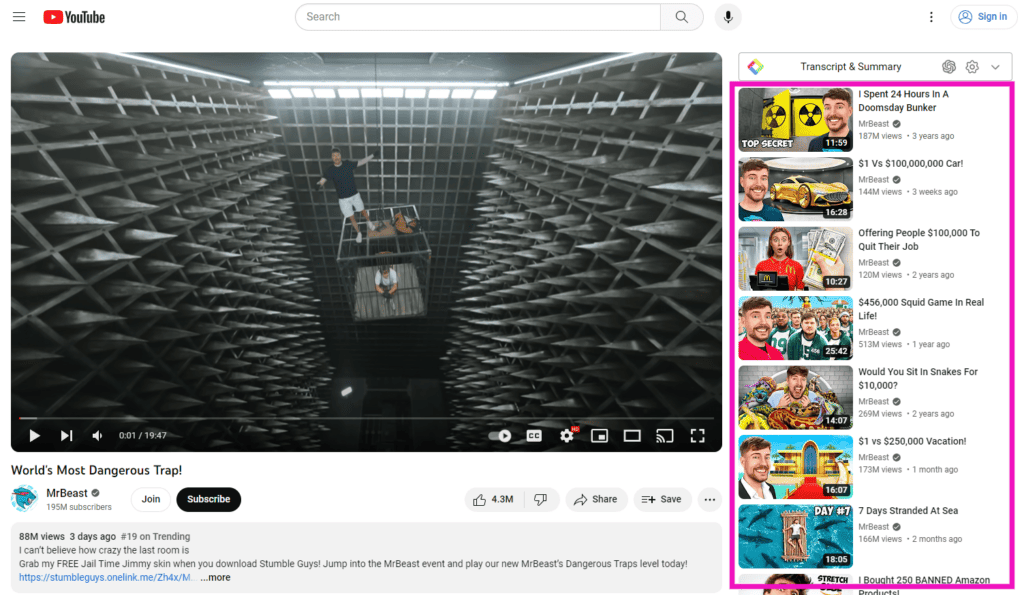
YouTube Search
When you search for a video, YouTube displays content from its library based on the keywords you typed into the search bar. It tries to match factors like title, tags, content, and description to your query. But the algorithm plays a role here as well, so it won’t show the same results to every user.
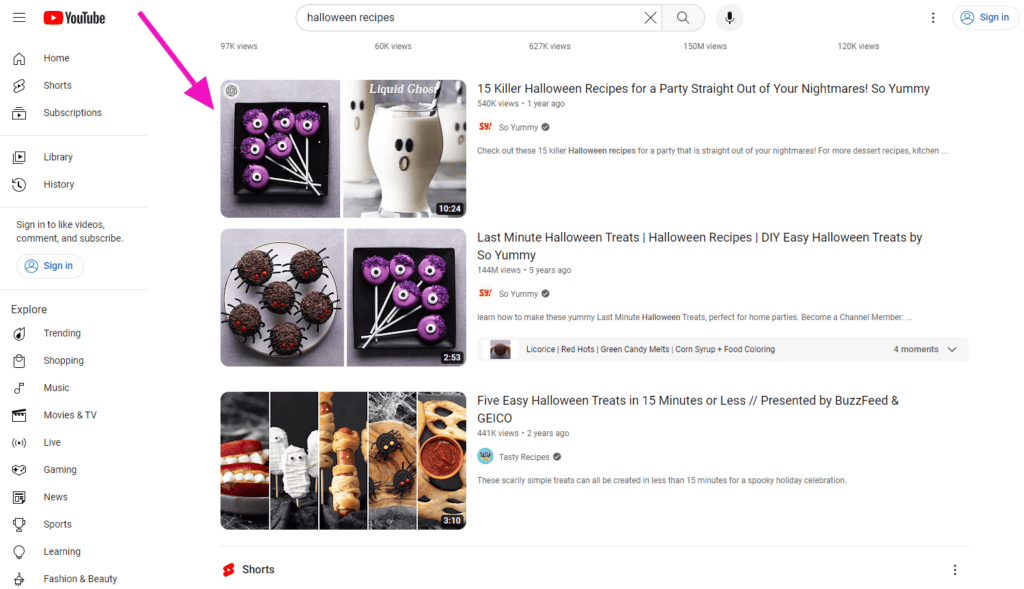
What is the YouTube Shorts Algorithm?
YouTube Shorts are short, vertical videos created using a smartphone and uploaded directly to the YouTube app. They are similar to Facebook Stories and TikToks.
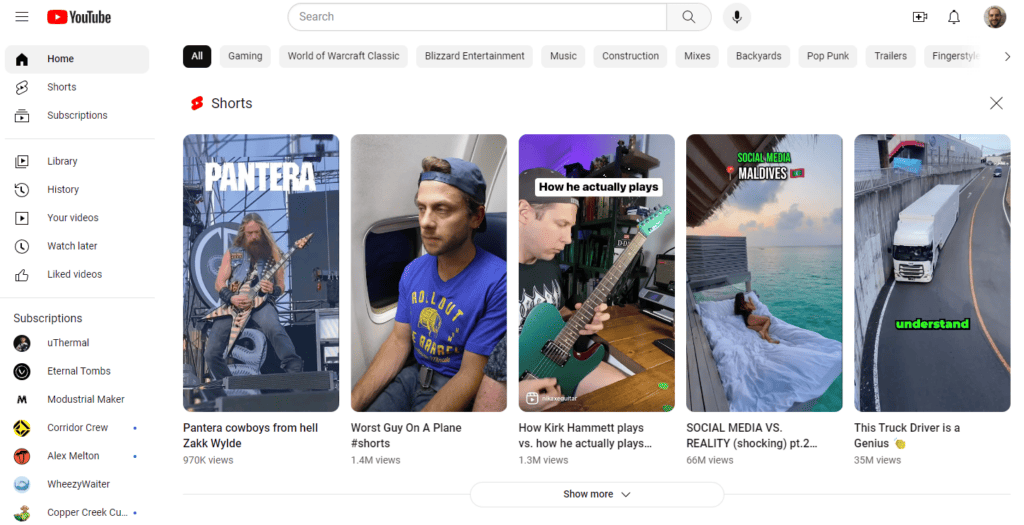
YouTube’s VP of Product Management described Shorts as “A new short-form video experience for creators and artists who want to shoot short, catchy videos using nothing but their mobile phones. […] Shorts is a new way to express yourself in 15 seconds or less.”
The YouTube Shorts algorithm is exactly the same as long videos. They are subject to the same signals. You’ll notice Shorts appear in several places on your homepage.
The Future of the YouTube Algorithm
What does the future of YouTube look like? It’s hard to imagine that YouTube will drastically change the algorithm again in the future. There will be refinements and optimizations, of course, but the core function of the algorithm is solid and effective.
How to Make the YouTube Algorithm Work for You
Now that you understand how the YouTube algorithm works, let’s talk about some ways you can take advantage of it to expose your content to more viewers.
1. Craft Your Titles Descriptions Well
The video title and text displayed beneath your uploaded video are valuable assets. Dedicate time to create an informative and SEO-optimized video title and description to ensure the algorithm fully grasps your video’s purpose.
Once you have conducted thorough keyword research, seamlessly incorporate these keywords into your title and description using natural language. This will enhance your chances of appearing prominently in YouTube’s Search Engine Results Pages (SERPs).
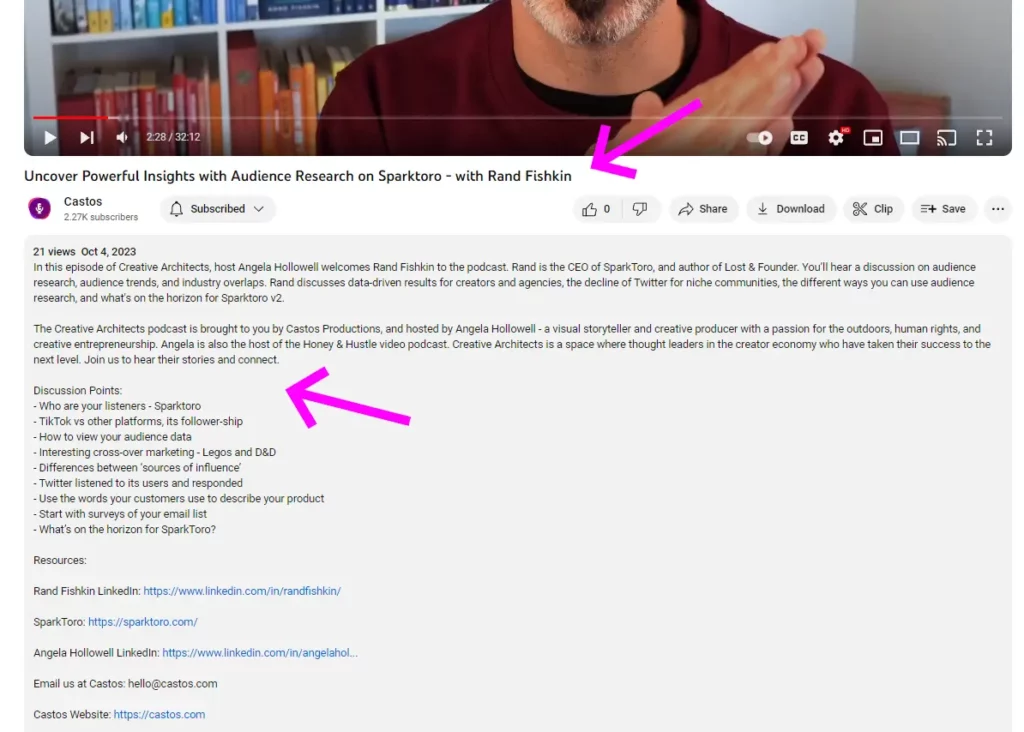
2. Increase Viewer Watch Time
From YouTube’s perspective, the longer a person watches a video, the more they like the content. So watch time is a very important metric to YouTube.
This means one of the best ways to convince the algorithm to show your video to more people is to get your viewers to watch more of each video. Your goal is to get your viewers to watch your entire videos right to the end, but that isn’t always possible.
Start by creating interesting and engaging content that your audience cares about. Don’t just produce videos because you want a YouTube channel. You have to give value.
Throughout your content, drop hints about what’s coming up in later parts of the video. This is a great way to keep your viewers excited about what’s to come. Many successful YouTubers tease the most valuable part of their content during the videos introduction.
3. Create Videos on Popular Topics
Topic popularity doesn’t guarantee placement in someone’s YouTube feed, but it does get a bit of a bump, especially on the homepage. ToutTube loves to recommend videos on highly trending topics because their good at roping people into new niches.
Google Trends is a great tool to discover what’s trending. Use it to identify trending topics that overlap with your niche.
It’s also a useful tool to learn when some topics are more popular. For instance, gardening topics are more popular in March and April, so if you create a gardening video, this is when you should publish it.
4. Create Compelling Thumbnails
Clicks are not a factor of YouTube’s algorithm anymore, but users still have to click on your videos in order to trigger other metrics like watch time and percent-to-completion.
Spend some time experimenting with different thumbnails until you find a format that works best for your audience.
Take MrBeast for example. Notice how all of his thumbnails use vibrant colors, brief text, and his smiling face. He knows exactly what works best for his audience. That isn’t to say it will work for yours, of course.
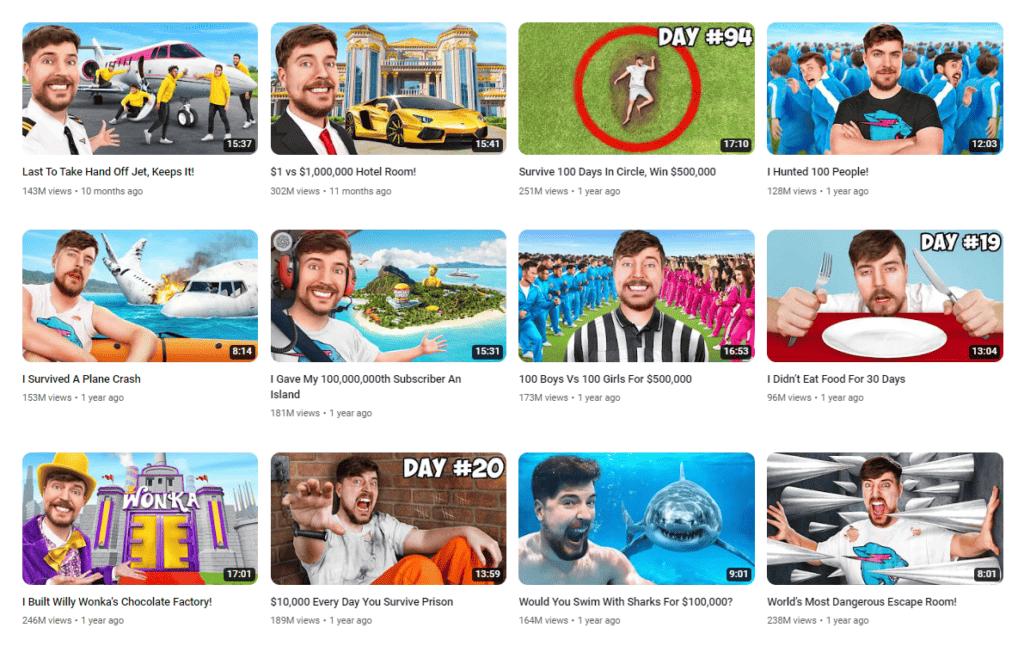
5. Prompt Your Viewers to Subscribe
More subscribers means more people like your content. If you can get your viewers to subscribe, YouTube will recognize your content as valuable and recommend it to more people.
How do you get more subscribers? Well, that’s a big question, but here are some basic tips.
- At some point in the video, simply ask your viewers to subscribe.
- Add a “please subscribe” watermark to the video to remind viewers.
- Ask them to subscribe in the video’s subscription.
6. Create Series and Playlists
A video in a series or playlist encourages viewers to see what’s next. If the viewer has autoplay enabled, your videos often play next automatically. Simply organize your videos into playlists for increased views, which helps with the algorithm.
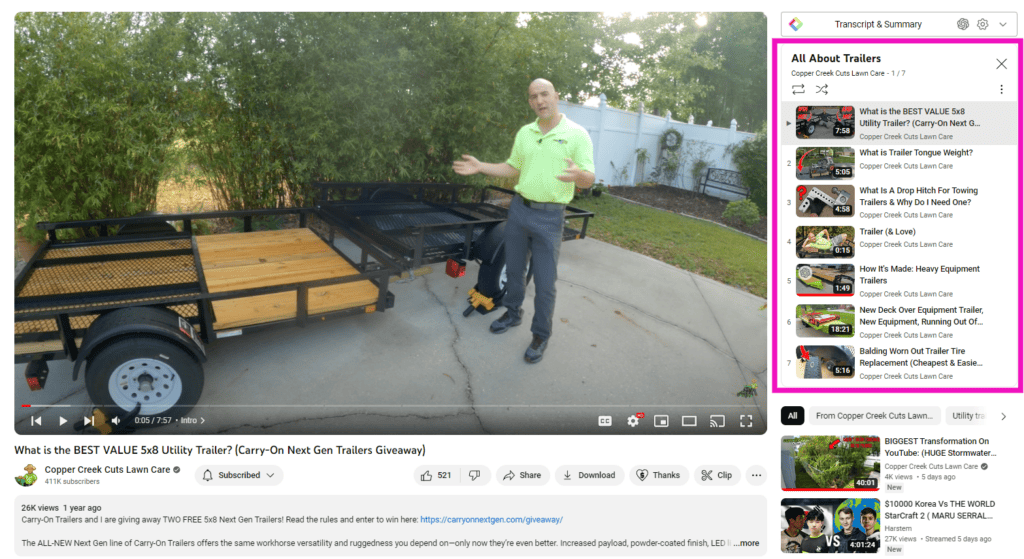
That said, don’t throw a bunch of unrelated videos into a playlist. Organize them in a reasonable way that makes sense for your viewers and adds value to their experience.
7. Watch Your Competitors
One of the best ways to improve your performance on YouTube is to monitor what works for your competitors in the same space. If you notice a similar creator leaning into a particular YouTube strategy, consider experimenting with it yourself.
8. Add Timestamps to Your Videos
Timestamps help viewers navigate your videos by skipping ahead or returning to different parts of the video. This is a great way to facilitate a good user experience. Happy users watch more of your videos, which looks good to the algorithm.
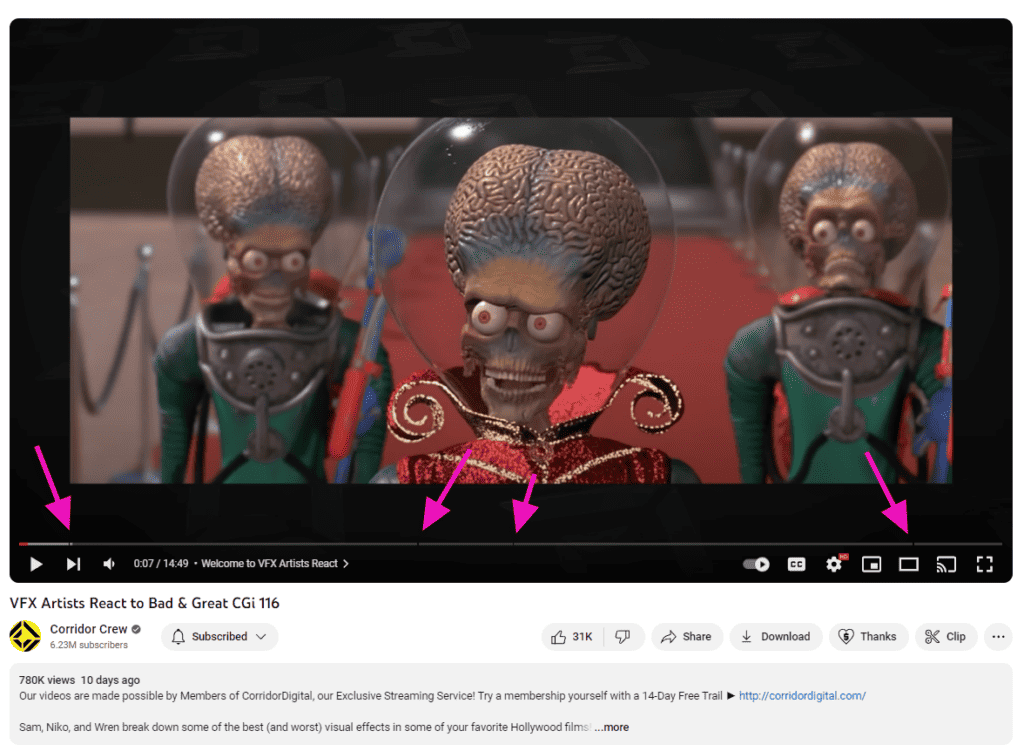
9. Avoid Using Click Bait
The term click bait gets used broadly, but it refers to images, titles, or descriptions that don’t match the actual content. The goal is to mislead you into clicking.
Click bait was an effective strategy back in the early 2000s when YouTube rewarded videos for getting clicks, but this method is annoying and ineffective these days. It’s a great way to get people to hide your channel from their feed.
That said, it’s perfectly fine to use captivating titles that compel users to click. For instance, “5 ways your bank is stealing from you” is attention-grabbing, but not click bait as long as your video actually discusses banking.
YouTube Algorithm FAQs
We’ve covered a lot about the YouTube algorithm, but you may have some more questions.
Is the YouTube Shorts algorithm different?
As of 2023, YouTube Shorts uses the same algorithm as the overall platform. That said, YouTube is always tweaking and optimizing its algorithm, so this may change. It’s important to keep yourself notified of any YouTube related news so that you are always producing content that does well on the platform.
How does YouTube count views in 2023?
As of 2023, we don’t know exactly what constitutes a “view.” However, the consensus is that a view requires these two conditions: 1) a video play for a verified IP address, and 2) the video is played for more than 30 seconds.
YouTube has a robust filtering system that identifies and removes fraudulent views and deceptive methods, ensuring that only genuine viewer engagement contributes to the view count.
How often should you post on YouTube?
YouTube asserts that the timing of your uploads doesn’t impact video recommendations. Nevertheless, maintaining a consistent posting schedule encourages viewer retention and increases opportunities for viral content. Ideally, aim for at least one weekly upload, but ensure it aligns with your interests. Burnout can harm your content quality, and the algorithm won’t favor it either way.
Create for Your Audience, Not the Algorithm
Well it’s important to understand how the YouTube algorithm works, that doesn’t mean you should create content solely to exploit it. YouTube is very user-centric these days. It displays personalized recommendations to users, which means the best way to build up your subscribers is to focus on your audience. If you create amazing content they love, the algorithm will reward you with exposure.

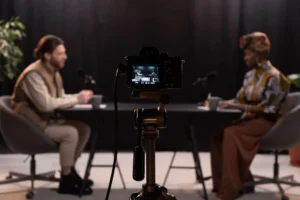

Comments are closed.